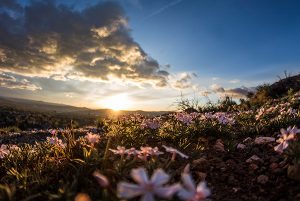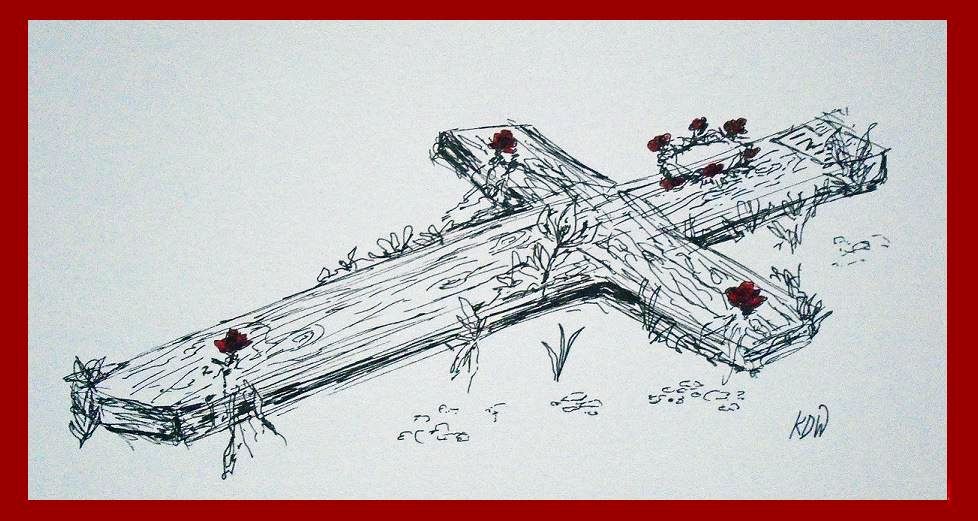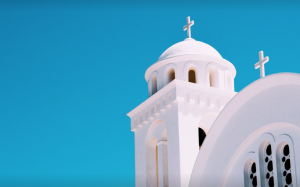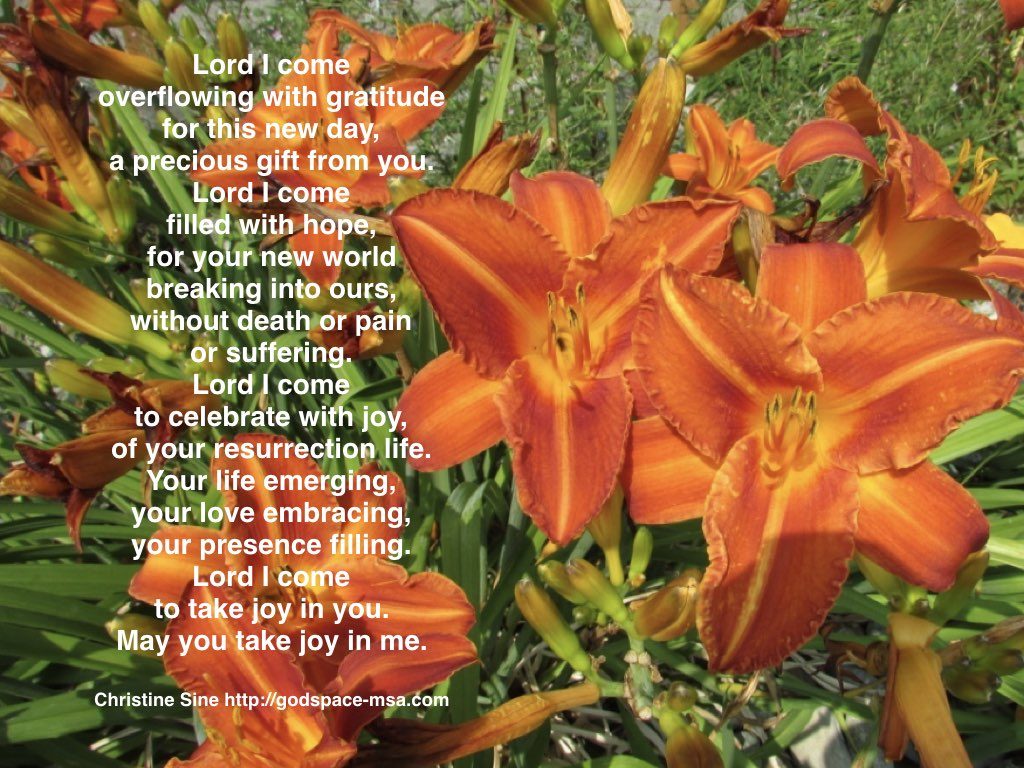By Ana Lisa de Jong—
 Everything is thank you
Everything is thank you
if you look carefully.
The trees that lose their leaves
still raise their limbs.
The earth farewells the sun,
and moves around again.
Those we love draw tears and smiles from us
in unison.
Everything is grace,
and begins again.
We know this because each new day
speaks of redemption.
Because Peter denied his friend
and was forgiven.
Because the sleep that restores us,
in a small way reflects the resurrection.
Each small death, brings life,
and each gift of surrender, is an offering.
A down payment
for the new day coming.
For every Friday is followed
by a Sunday.
And every empty grave
formerly held something.
Yes everything is thank you
if you look carefully.
Everything in nature, love and life
reveals the resurrection.
He who bore our sin, pain and grief
lives again.
And our cross, so hard to bear
we find lifts us to heaven.
Yes everything that happens we can thank him.
For we know our story lives in his,
without an ending.
Ana Lisa de Jong
Living Tree Poetry
April 2017
By Tom Sine —
Waking up to the discovery of a world at risk: Earth Day 1970
“Get this garbage out the lobby now,” shouted the manager of the Kahalui Motel. It was April 22, 1970. Ed Yamamoto, student body president of Maui Community College and 12 other students had just stacked the last of 60 huge black bags of trash in the lobby of the motel, ignoring the shouting of the motel manager. They had just collected this trash from an enormous mountain of garbage that motel staff had put out on the beach two hours earlier for the ocean to take away, which staff did every week.
The students didn’t respond to hours of shouting as the manager railed at them. Finally, after 7 hours of a standoff the manager caved into the students protesting promising to have garbage picked up in the future by the local garbage service.
Remembering unawareness
As we celebrate Earth Day, this April 22, it is essential to understand that there was virtually no awareness in 1970 that we were facing any environmental challenges in the future. What motivated these students in 1970, who had never been a part of any protest before, to become environmental activists?
Believe it or not, in 1970 virtually no one was aware that our planet was facing environmental challenges. So when Dr. James Dator from the University of Hawaii presented us a very daunting range of environmental crises, everything from dangerously polluted air and water to disappearing forests, it arrested our attention.
What the movement meant for me
This wake-up call also motivated me to move to Seattle and pursue a doctorate at UW. I wanted to join those young activists who were seeking to address some of the daunting new challenges facing a people and a planet as we raced towards the 21st century.
In 1981 I wrote a book encouraging Christians to wake up to the new challenges that were likely to face us as we headed towards the nineties from widening gap between rich and poor and our need to dramatically reduce our pollution of air and water titled The Mustard Seed Conspiracy.
I wrote a book in 1991 entitled Wild Hope that directly challenged Christians to join those working to dramatically improve the stewardship of our threatened environment. I received a very positive response from leaders in both mainline and Catholic churches. However, it seemed to be a little early for many evangelicals to engage this important issue.
Honoring Creation
As we look at the escalating environmental challenges we are likely to face 2017 to 2027, it is essential that we start by going back to the Bible and reminding ourselves of God’s loving purposes for both our lives and for God’s world.
Let me start by affirming I am persuaded that that scripture teaches that this world is our home. “We aren’t just passing through!” The Bible also affirms that that in “Christ, all things will be made new.” In NT Wright’s book, Surprised By Hope, and a number of his other books as well as those of other authors. Wright makes a convincing case that the scripture teaches we that our great Easter Homecoming will not to be in the clouds. Rather he states we will come home as to a new heaven and a new earth where all things are made new.
We will come home to a restored creation in which healing finally comes to the broken, justice to the poor, peace to the nations and God’s good creation will also be restored not vaporized. Listen to the powerful imagery of the prophet Isaiah.
“The desert and the parched land will be glad;
the wilderness will rejoice and blossom.
Like the crocus, 2 it will burst into bloom;
it will rejoice greatly and shout for joy.
The glory of Lebanon will be given to it,
the splendor of Carmel and Sharon;
they will see the glory of the Lord,
the splendor of our God.3 Strengthen the feeble hands,
steady the knees that give way;
4 say to those with fearful hearts,
“Be strong, do not fear;
your God will come,
he will come with vengeance;
with divine retribution
he will come to save you.”5 Then will the eyes of the blind be opened
and the ears of the deaf unstopped.
6 Then will the lame leap like a deer,
and the mute tongue shout for joy.
Water will gush forth in the wilderness
and streams in the desert.
7 The burning sand will become a pool,
the thirsty ground bubbling springs.
In the haunts where jackals once lay,
grass and reeds and papyrus will grow.”
Clearly, God’s purposes are not just the restoration of our personal lives. The creator God does intend to make all things new including this good creation. Therefore working for the care of God’s good creation is not just the agenda for those on the political left. All of us who are followers of Jesus Christ need to make God’s loving purposes for a people and a world our purposes, don’t we?
Now as we prepare to celebrate Earth Day on April 22, 2017 we need a wake-up call. The future of God’s good creation is much worse than we ever could have imagined in our worst nightmares on that first Earth Day in 1970. Reefs are dying, glaciers are melting, arable farm lands are rapidly declining and which is causing growing famines right now that are threatening the lives of millions of our neighbors in Africa.
On April 22, 2017 it is estimated that almost a billion of us from 192 nations will join together to not only celebrate Earth Day but to explore how we all can dramatically increase investment our environmental renewal caring for God’s good creation. I encourage all of us to not only join the celebration but to also join a new generation of change makers and creation care activists planting gardens, empowering those at the margins and advocating for environmental justice.
Join a new generation who live like they give a damn!
I find one of the greatest reasons to be hopeful is that God seems to be raising up a new generation many of whom are more thoughtful about every aspect of their lives in terms of environmental stewardship in terms of the clothes they buy and the food they consume. They are also much more active personally and politically in working to find ways to improve our endangered island home.
Today millennials , 18 to 35 year olds, are even more involved in working for both environmental renewal and economic justice than the young activists on Maui in the 70s. Since millennials are the first digital generation they are much more aware of issues of environmental, economic and racial justice. More importantly they are not only more aware a higher percentage of them want to use their lives for serious change making.
Atlanta Harvest
For example, Bethaney Harrington, as a college student at Emory University, was invited to imagine a whole new way to enable her church to create a more sustainable future in Atlanta. She and her fellow students were members of an Intervarsity team creating new forms of urban empowerment. They created a new urban innovation called Atlanta Harvest.
Essentially they created an urban farm project on some abandoned land just three miles from downtown instead of importing produce from farms a hundred mile away. Consumers in this area of Atlanta buy locally grown vegetables which reduces the amount of fuel used to transport the from many miles away. They were also able to provide fresh produce for those at the margins who often could not afford it.
The V3 movement, drawing on some of the ideas from The New Parish, are encouraging new church plants to become more involved in creating more sustainable local communities. Sean and Julie Hall an example of church planter who are leading this parade. They are planting a church called the Fountain Parish in Bellingham Washington which is one of the most sustainable cities on the west coast. They are also planting in a low income neighborhood. Instead of starting a food bank for they invited their neighbors to join them in a community venture of planting vegetable gardens in everyone’s back yard that wants to participate.
Pro-environmental, Pro-family
In April 2017 our small planet is much more at risk that it was on that first Earth Day. Our reefs are dying, the climate is warming and frankly the future for our children and grand children is increasingly in peril.
To make matters much worse the current administration in the US has slashed funding for the EPA environmental renewal by 31%. as well as undermining a growing range of environmental programs to restore air, water and land. They have also just reversed the commitment to reduce carbon emissions. It also Looks like the US is going to pull out the Paris Environmental Accord with 200 other nations which would dramatically undermine our global efforts to improve our environment while there is still time.
As a consequence not only the future of the planet but the future of our children and grandchildren as well as families all over the planet will be in growing peril in the next two decade unless we reverse these serious cutbacks. This not only a pro-environmental, pro-justice issue. It is also a pro -family and a pro-life issue for all followers of Jesus. I recommend Making Peace With the Land by Norman Wirzba. He enables us in this book to grasp how vitally our biblical faith connects to our care of God’s creation.
Do you have an interest in this conversation? I’d love to hear your insight! Email me at: twsine@gmail.com
God of the all and the nothing
the making and unmade at the same time
the span of the universe and the seed
You believe in me and I must believe in You
the wheel turns, the fire burns
Allelujah, Allelujah
by Christine Sine
Welcome to Easter and welcome to Earth Week. It seems so fitting to me that this first week of the Easter season also celebrates God’s good creation. The promise of Easter is not just of transformation and renewal in our lives, it is a promise of transformation of all that God has created.
Tom and I will spend Earth Day, April 22nd in Canada conducting a Spirituality of Gardening Seminar. The following day Good Seed Sunday, we will celebrate at Cedar Park Church in Ladner. I love this celebration which sadly is often neglected by our churches. I think should be at the forefront on our yearly rhythms.
God created us from the earth and for the earth. In Food and Faith: A Theology of Eating, theologian Norman Wirzba affirms: When we become strangers to the earth we have lost more than our roots; we have lost touch with the rhythm of life. Where life once was seasonal and secure it is now episodic & erratic. We live after the fall… unblessed on earth and unconnected to heaven. And in Making Peace with the Land, he goes on to say: God’s first love is the soil. This is how it has to be, because without healthy soil and the fertility and food it makes possible, there would be no terrestrial life of any kind. God’s love for us – described definitely in John 3:16 as God’s giving of his son to us – only makes sense in terms of God’ love for the earth that sustains us.
Provocative words for us to contemplate as we enter the Easter season and celebrate our role as stewards of God’s good creation. Yet scientific evidence is growing to support this. Living near nature dramatically impacts our health and interaction with nature decreases the health gap between rich and poor.
Contact with nature helps children to develop cognitive, emotional, and behavioral connections to their nearby social and biophysical environments. Nature experiences are important for encouraging imagination and creativity, cognitive and intellectual development, and social relationships. Kids in particular who suffer from nature deficit disorder and attention deficit disorder can have their symptoms alleviated by spending more time outdoors. Exposure to dirt increases happiness and even sniffing compost gives us joy .
Early Christians believed that God spoke through two books – the book of the Bible and the book of Creation and I think it is time for us to rediscover and start to learn from this second book.
I often say that I read about the story of God in the bible but in nature I experience it. Life, death and resurrection is all around us. Reading the story as it is lived out in God’s garden reaffirms our faith and teaches us enriching lessons about the God we love.
As we get ready for Earth day here are a few suggestions on how to celebrate:
- Educate yourself about our responsibility to creation and the Christian organizations that make this a priority. In Canada, where the Sunday after Earth Day is known as Good Seed Sunday, A Rocha has created a number of resources to help celebrate. Another organization that provides some great resources for the season is Let All Creation Praise and The Christian Food Movement provides another important free downloadable resource for us.
- Preach about God’s love for creation and our responsibility as stewards. The bible is rich with verses that speak of God’s love for our planet and all created beings. One of my favorite passages is Ps 65 which tells us that God is the hope of all creation. I adapted this a couple of years ago as part of a liturgy for creation that you might find interesting.
- Do an eco-audit of your church. How green is your church? When our church, St Andrews Episcopal in Seattle asked this question a few years ago, it led to a lot of changes in the way things were done. We started using recyclable plates, and cups at coffee hour, composted all waste food to use in the vegetable garden that sprang up in the church grounds and solar panels were built on one of our buildings and some of us love to watch the energy consumption going backwards at certain times of the day. Other initiatives are planned for the future. If you are not sure where to start check out eco-justice ministries which has some great suggestions on how to go about this
- Get your kids out into nature. There is a growing movement to take kindergarten outside and I think that, at least for Earth Sunday we should do the same with children’s church. A couple of years ago I started a Pinterest board to share ideas on creative ways to engage kids outside in the garden. Many of these from painting rocks, to planting seeds could be adapted for use on Sunday. Kids love watching things grow and having the opportunity to eat what they have grown is an exciting experience for them.
- Extend your celebrations into the neighborhood. My friend and colleague Andy Wade has taught me a lot about how to reach out into our neighborhoods through the celebration of creation. In this article he suggests everything from creating neighborhood orchards, free libraries and seed libraries to redesigning your front yard to invite neighbors in.
- Have some fun. I always plan some fun projects to go along with my spirituality and gardening seminars and on Saturday will have participants making seed bombs. It is always popular with both kids and adults. All it takes is some air dry clay, compost and wildflower seeds. Then send the kids out to sow their bombs in waste areas around your neighborhood.
What Is Your Response?
What would happen if we all took Earth Day seriously this year? I want to challenge all of us to enter into the resurrection by fulfilling our God given responsibility of stewarding our earth. Let us shout and sing with all creation and with God the creator of all in joyous celebration of this beautiful earth, an amazing gift from God.
 Blood curdles into the grain
Blood curdles into the grain
Mixes fresh with old
Responding, the sap sings
Though long dead and now discarded
Roughly hewn and unplaned
Yours the only carpenter’s hands
It has ever known
Sings then, and rises
Green shoots writhing
With untameable life
Curling, encircling the rusting nails
Budding in split beams
Filling the cracks with flowers
Rising from wooden wounds.
Art and text © Keren Dibbens-Wyatt

by Lynne Baab
Holy Saturday is the day of hushed stillness between Good Friday and Easter. The disciples mourn because this powerful and loving One, who promised to bring life, is dead. The angels weep that the beloved Son of God has been forcibly, but willingly, separated from his Father in the cruelest imaginable way.
Where was Jesus on Holy Saturday?
Was he lying quietly in the tomb, truly dead, while his Father planned the resurrection?
Was he in hell? In the Apostle’s Creed we say that we believe in Jesus Christ, God’s “only Son Our Lord, Who was conceived by the Holy Spirit, born of the Virgin Mary, suffered under Pontius Pilate, was crucified, died, and was buried. He descended into Hell; the third day He rose again from the dead.” Some theologians argue that Jesus broke open the power of hell by invading it as a Righteous One.
Was he in the realm of the dead, but not in hell? Acts 2:31 reads, “Foreseeing this, David spoke of the resurrection of the Messiah, saying, ‘He was not abandoned to Hades, nor did his flesh experience corruption’” (NRSV). Biblical scholars argue that Hades is not the same as hell, but instead means some sort of realm of the dead, and this verse may indicate that Jesus went there after his death, but of course, did not stay there.
Was he preaching the gospel to the dead or to angels, powers and principalities? 1 Peter 3:18-19 (NRSV) reads, “He was put to death in the flesh, but made alive in the spirit, in which also he went and made a proclamation to the spirits in prison.” Some commentators argue Jesus was in hell or Hades, preaching to souls there. Others say that “spirits” in the New Testament only refers to angels or demons, so if he was announcing something to spirits, he was probably communicating to angels and demons that he had conquered death through his own death.
Kimberlee Conway Ireton, in her excellent book on the church year, Circle of the Seasons, describes an Eastern Orthodox icon showing Jesus “striding victoriously into hell and reaching out in love even to the dead and the damned.”[1] She notes that this image reminds us that there is no place that God is not. And in the Eastern Orthodox tradition, even on Holy Saturday when Jesus’ body lay in the tomb, he was bringing freedom to captives and prisoners.
Kimberlee summarizes the paradoxes of this day:
Holy Saturday, then, is a day of contrasts. We mourn our dead Lord even as we prepare for the celebration of his resurrection. We grieve his broken body lying in the tomb even as we celebrate his triumphant march against the gates of hell. We sorrow at the foot of the empty cross even as we anticipate the true and glorious meaning of its emptiness.[2]
Kimberlee writes about one year when she ate only cold food between the Maunday Thursday service at her church and Easter morning. Cold food, she says, means that no electricity has been used in preparing it, mirroring in a small way that the Light has gone out of the world.[3]
Holy Saturday is an excellent day for any kind of fasting, perhaps from a favorite food item, a form of technology, coffee drinks, entertainment media, or shopping. The Light has gone out of the world, and on this sad day we are invited to enter into the sadness and emptiness of that reality.
On Holy Saturday, where was Jesus? In the tomb? In hell or Hades freeing prisoners and captives? Somewhere in the universe proclaiming to angels and demons his victory? Whichever it was, he was cruelly separated from his Father for our sakes, waiting for the resurrection. Praise God for his great gift to us in Jesus. May we pause on this day and remember.
[1] Kimberlee Conway Ireton, The Circle of the Seasons: Meeting God in the Church Year (Downer’s Grove, IL: InterVarsity Press, 2008), 82.
[2] Ibid., 83.
[3] Ibid., 85-86.

As an Amazon Associate, I receive a small amount for purchases made through appropriate links.
Thank you for supporting Godspace in this way.
When referencing or quoting Godspace Light, please be sure to include the Author (Christine Sine unless otherwise noted), the Title of the article or resource, the Source link where appropriate, and ©Godspacelight.com. Thank you!


